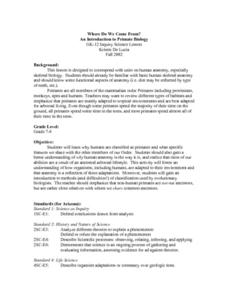Curated OER
Head, Shoulders, Knees and Toes
Students gain a greater comprehension of the anatomy and physiology of the muscular system, the skeletal system and connective tissue by researching joints in the body. They also reflect on the effects of injuries on their joints and...
Curated OER
Human Anatomy -- How Do We Move?
Students create a model of the digestive system. In this human anatomy lesson the students examine features of the digestive system. The students perform an experiment.
BioEd Online
The Skeleton
Don't be chicken to try a lesson plan that compares the anatomy of birds to humans. Read the background information so you don't have to wing it when it comes to the anatomy of a chicken. Prepare cooked chicken bones by soaking them in a...
Curated OER
Your Amazing Body
Students examine the different body systems and how they are interdependent on each other. In this body systems lesson students draw the body and its parts.
Curated OER
MuscleMania
Students learn three different types of muscles. By building a model of the arm, they learn its basic anatomy and how muscles function in relationship to bones. They perform an experiment on the relationship between muscle size and...
Curated OER
Where Do We Come From? An Introduction to Primate Biology
Seventh graders explore skeletal biology. Through a discussion and video observation, 7th graders investigate how the anatomy is adapted to the environment. Students study primates and explore their characteristics and behaviors.
Curated OER
Human Traces
Students create and construct human skeletons by rubbing casts of bone impressions on paper, and then label most important components of human skeleton.
Curated OER
Mathematics In You
Students construct ratios using the hand as data. They use examples of cortical and trabecular bone found in the long bones to measure circumference, diameter, length, and weight of long bones. They perform computations using growth...









